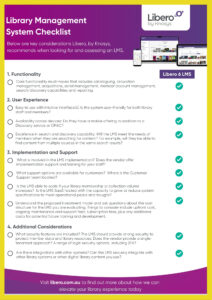Choosing a library management system (LMS), or integrated library system (ILS), is an important decision for your library. The system will function as the central hub for your collection, community, and business analytics. Your LMS needs to deliver efficiencies and the best experiences for staff and members.
Download LMS Checklist
Libero, by Knosys has outlined the key considerations to keep in mind when evaluating your next system. You can explore them below – or download the checklist for a quick, shareable reference.
1. Functionality
- Core functionality must-haves that includes cataloguing, circulation management, acquisitions, serial management, member account management, search/discovery capabilities and reporting.
2. User Experience
- Easy to use with intuitive interface(s): Is the system user-friendly for both library staff and members? Library members should be able to quickly grasp and find what they need, borrow materials, and manage their accounts without extensive training.
- Availability across devices: Do they have a mobile offering in addition to a Discovery service or OPAC? A mobile library app will complement your main LMS by offering the same functionality on mobile devices.
- Excellence in search and discovery capability: Will the LMS meet the needs of members when they are searching for content? For example, will they be able to find content from multiple sources in the same search results?
3. Implementation and Support
- What is involved in the LMS implementation? Does the vendor offer implementation support and training for your staff? A flexible approach to staff training is essential to ensure the successful implementation of your new LMS.
- What support options are available for customers? Where is the Customer Support team located?
- Is the LMS able to scale if your library membership or collection volume increases? Is the LMS SaaS hosted with the capacity to grow or reduce system specifications to meet operational peaks and troughs?
- Understand the proposed investment model and ask questions about the cost structure for the LMS you are evaluating. Things to consider include upfront cost, ongoing maintenance and support fees, subscription fees, plus any additional costs for potential future training and development.
4. Additional Considerations
- What security features are included? The LMS should provide strong security to protect member data and library resources. Does the vendor provide a single-tenanted approach? A range of login security options, including 2FA?
- Are there integrations with other systems? Can the LMS securely integrate with other library systems or other digital library content you use?
Don’t forget to:
- Gather vendor references: Ask the vendor for references from current and past clients with similar library needs.
- Research and read reviews: Read online reviews and comparisons of different LMS options.
This checklist is designed to facilitate an informed decision-making process when selecting a library management system that aligns with your library’s specific needs.
To learn more about a Libero 6 LMS contact us today or request a demo.


